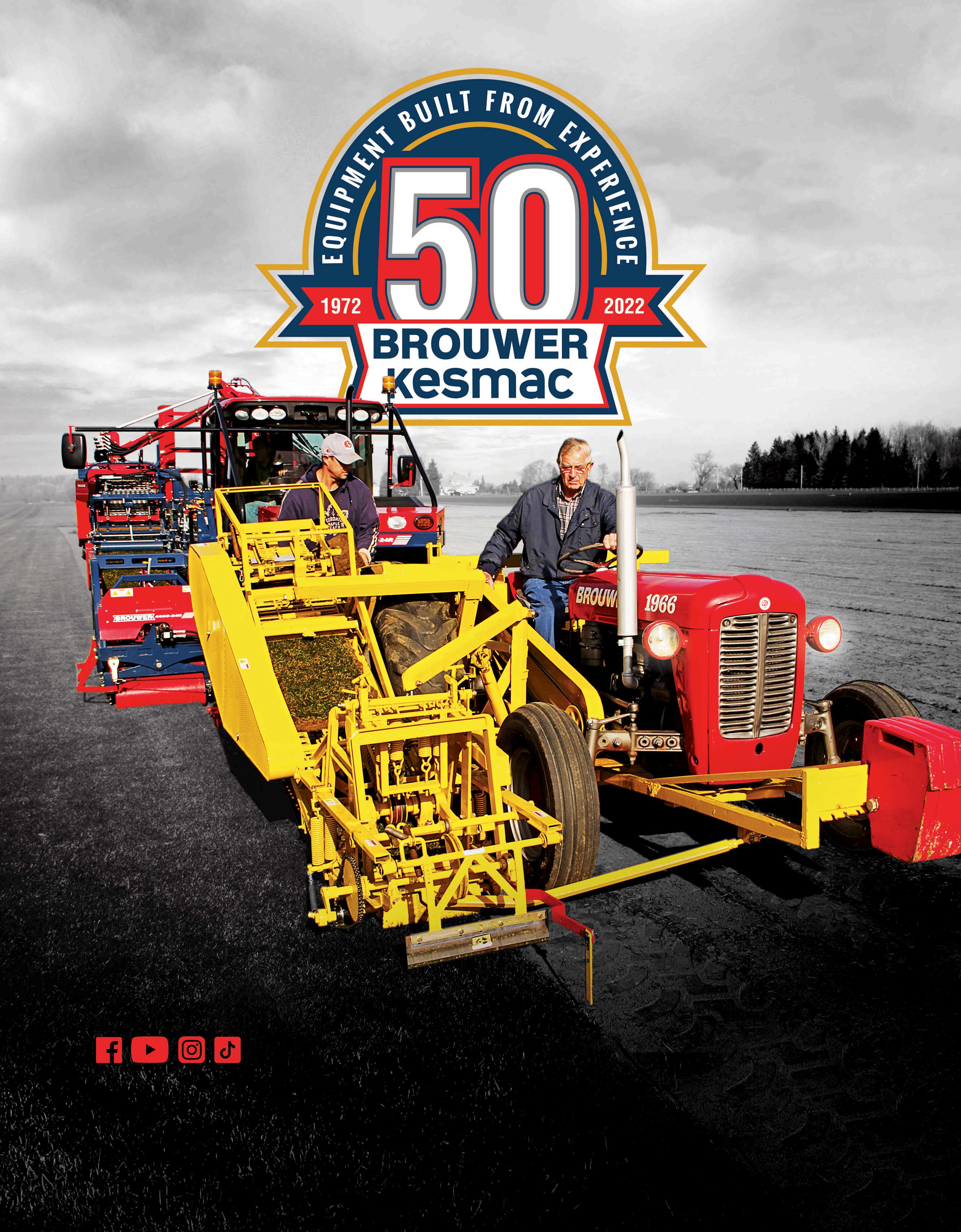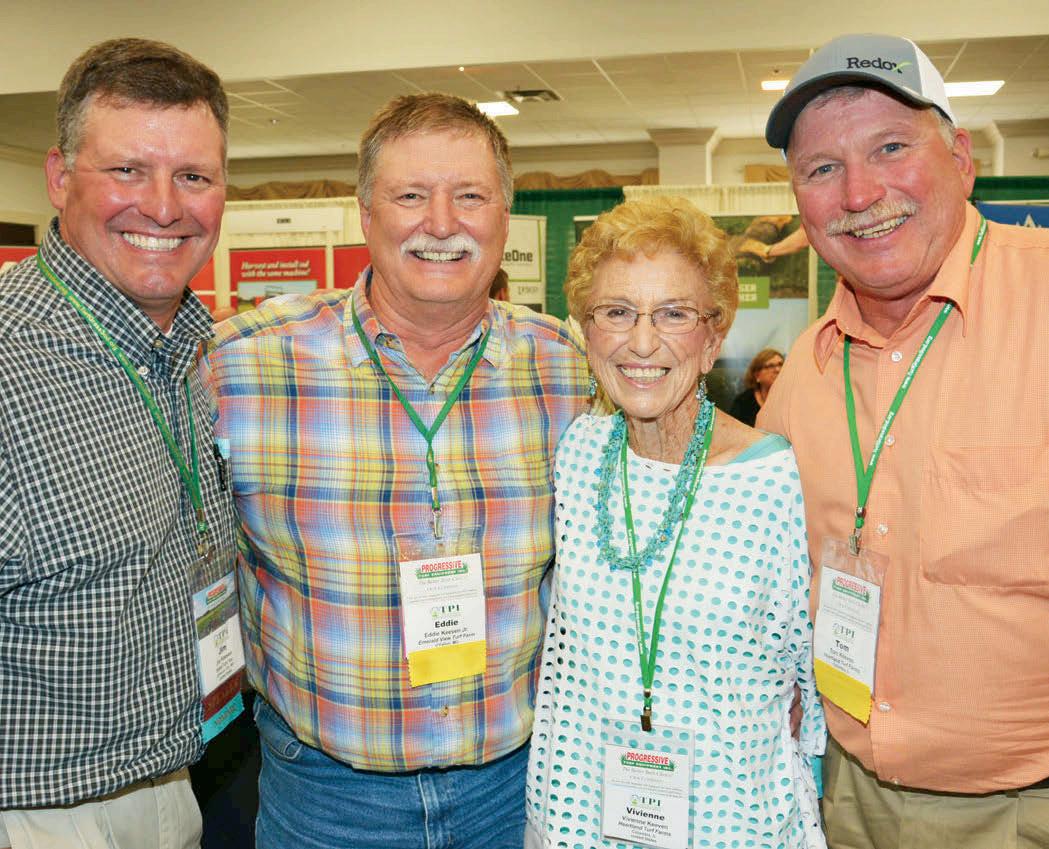
28 minute read
TPI President Jim Keeven—Growing the Legacy
TPI PRESIDENT JIM KEEVEN—
GROWING THE LEGACY
By Suz Trusty
Jim Keeven stepped into his new role as President of Turfgrass Producers International (TPI) on January 1, 2022, ready and able to take the helm of the association that has been part of his life since childhood. Keenly aware of the personal and professional benefits it offers, his goal is to grow the legacy of the association by increasing awareness of its relevance in the natural grass industry and growing its membership. He is growing a family legacy as well. Jim is the third Keeven brother to serve as TPI President. Tom served in 2001-2002 and Ed, Jr. served in 2014-2015.
This photo, taken in February of 2017 during TPI’s 50 Year Anniversary Celebration, shows Vivienne Keeven with three of her sons, all TPI Presidents. (From left to right: Jim, Eddie, Vivienne, and Tom)
Jim, and his wife Kathy, are co-owners of SelecTurf, Inc., located on the outskirts of Jefferson City, Missouri. Though the city is the state capital, its population is only 45,000. Jim says, “It still has the small town feel and we like it that way.” Jeff City is just 30 miles south of Columbia, the region’s business hub, and home of the University of Missouri. The location provides good access to their marketing area, which Jim says, “Is actually pretty small—Jeff City, Columbia, and Lake of the Ozarks—about 350,000 to 400,000. We do ship some sod to Kansas City, but the distance makes it harder for us to compete in that market.”
The Legacy Takes Root
It all began in 1951, when Edwin and Vivienne Keeven started installing sod in Florissant, MO, as Ed Keeven Sod Co., Inc. As the business grew, the Keevens decided to become growers as well. In 1963, Ed and Viv moved to O’Fallon, MO, and started a 120-acre turfgrass farm. During that time, the Keeven family was growing, too, reaching a total of eight. It was an even balance, with four girls—Vivian, Barbara, Judy, and Jeanne—and four boys— Ed, Jr., Tom, Marty, and Jim. “I’m the youngest,” says Jim. “The spoiled one according to all my siblings. But being ‘the baby’ didn’t exempt me from working in the fields during the summer, in the morning before school, and again after school. There was always grass to mow and we were still moving irrigation by hand. We joke that’s why my Dad and Mom had so many kids. They wanted more workers.” Jim reports his parents were even more than great role models, setting high standards, they were excellent teachers and mentors. “We all knew what was expected of us. Whatever the task, wherever you were, you did it, and you did it right.” Faith has always been a huge part of the family dynamics. Jim says, “Mom and Dad laid a good foundation. As a big Catholic family, and proud of it, we were always active in church. No matter how demanding the business was, we didn’t work on Sundays. That was the day for family
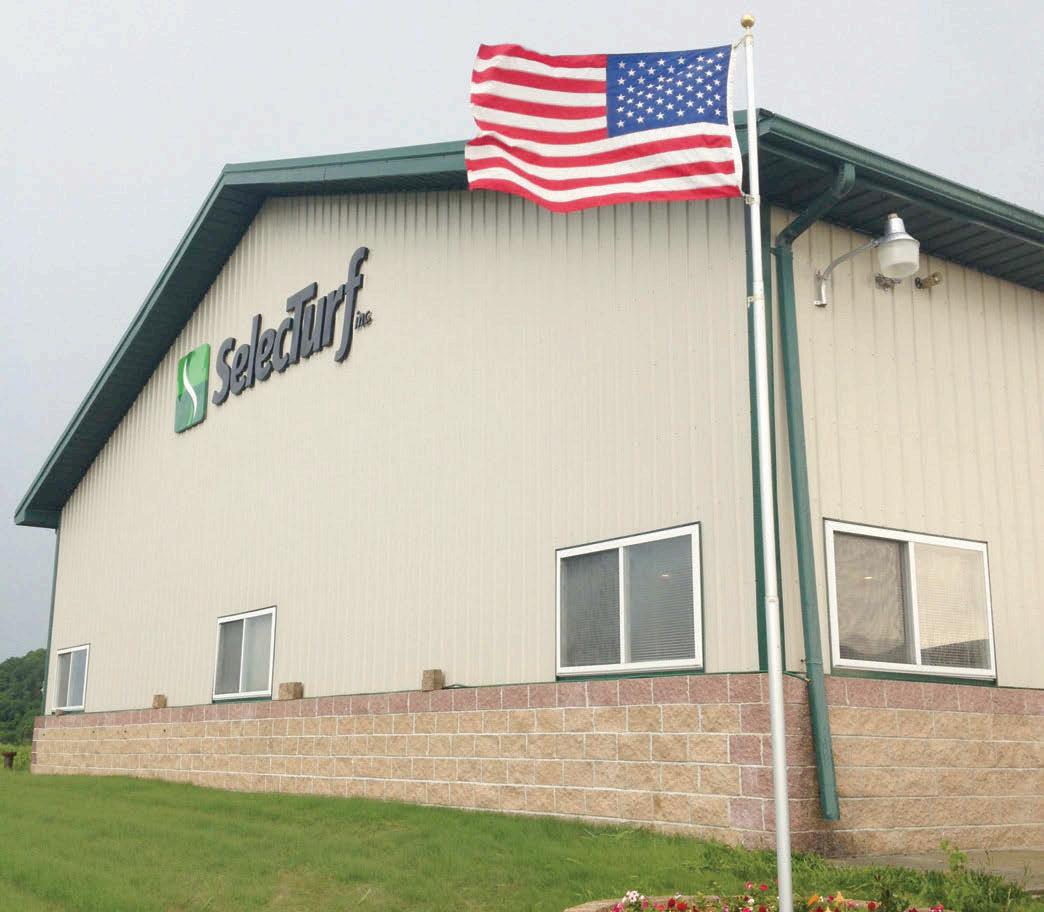
The headquarters of SelecTurf, Inc., has the American Flag proudly displayed.
Ed and Viv also were smart and forward-thinking businesspeople, always open to new ideas and developing strong networking connections within the community and through the American Sod Producers Association (which was renamed Turfgrass Producers International in 1994). Like so many TPI families, the Keevens planned their time off around the association’s conventions and conferences. Jim says, “That was our summer vacation. Dad and Mom bought an RV and we’d all pile in spending a week or more driving to the convention and seeing lots of different states along the way. We’d meet up with the kids of other sod growers and many became lifelong friends. The summer meeting in Toronto, Canada, in July 1972, was the first convention that I remember. We stayed in the RV Park in Burleigh Falls and the fishing was tremendous.” By 1973, Ed Keeven Sod Co., Inc., had grown to nearly 400 acres and the company changed its focus. Ed and Viv dissolved the installation business to commit their time solely to growing and selling top quality turfgrass. As part of their long-range planning, Ed and Viv developed an interesting concept to ensure their children’s higher education. Jim reports, “All eight of us started drawing a paycheck at age 12. Three-quarters of each of our paychecks went into one college fund to cover our college costs. It was a way for the turf farm to fund our college educations balanced by the write off as employees.”
Kathy and Jim—Setting the Stage
As kids, Kathy and Jim lived just three miles apart, but went to different schools. Though each knew of the other’s family, they didn’t meet personally until both were 16. Kathy’s Dad farmed nursery stock, growing Yews, and he also delivered drywall. Kathy tells this family story. On the way to church, their car broke down right in front of the Keeven’s farmhouse. Her Dad walked up and talked to Jim’s Dad who said just take my car. Ed Sr. pulled their car up to his shop and had it fixed by the time Kathy’s family got back from church. That’s just what good neighbors did. Jim says, “Kathy and I started dating shortly after we met, then took some time off in the relationship. By the time we were 18, we were back together.” The fall following high school graduation, Jim headed to the University of Missouri in Columbia to study agricultural economics. He says, “I’ve only had two jobs in my life, the turf farm and working in the ag department while I was in college.” He did not finish that degree. “After two years there, I thought I knew it all and wanted to work full-time. Looking back, I wish I had finished. It’s not so much the education you get in the classroom as the education you get from the college experience.”
The Power of Three
Jim came back to the farm at 20. When his Dad asked what his plans were, Jim said he wanted to be in the turf business. Ed, Jr. (Eddie), twelve years older than Jim, and Tom (Tommy), seven years older, had already been buying into the business and had some ownership. At that point, Ed and Viv had no more college education to fund and decided to pursue retirement a bit earlier than they had originally planned. Jim says, “They decided that once I had invested enough money in the company to get equal to Eddie and Tommy, they would sell the company completely. Dad thought about slowly backing out, but the lawyer told him it needed to be an arm's-length deal. Continuing to come to work and being funded by the company is just cutting back, not retirement.” In 1984, the three brothers, Eddie, Tommy, and Jim, bought the turfgrass farm from their parents and Ed Keeven Sod Co., Inc. began operations as Emerald View Turf Farms. Jim was just 21. That also was the year he and Kathy married, beginning their future together. And, while Jim says, “She puts up with a lot from me without a doubt,” it’s obvious they make a great team. During that first year, the brothers realized they would need to expand to support the three families. Their options were to get bigger in O’Fallon or seek out new locations. “In their retirement, Dad and Mom were spending time down at the Lake of the Ozarks, where they had a cabin,” says Jim. “They suggested that would be a good market for sod, and when we agreed, Dad started exploring for land for us. He found a farm in mid-Missouri, on Highway 63, just outside of Jefferson City.” In 1985, the brothers determined expanding Emerald View Turf Farms to that site was the right thing to do. Jim says, “Since Eddie and Tommy had both started their families,
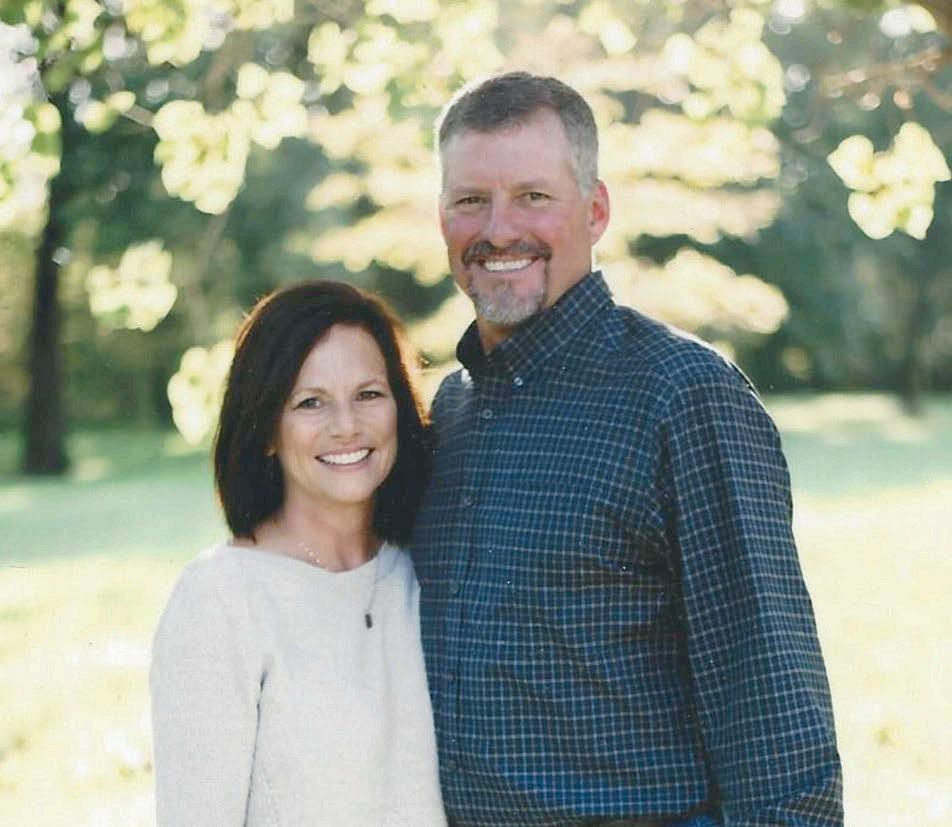
Jim and Kathy Keeven make a great team.
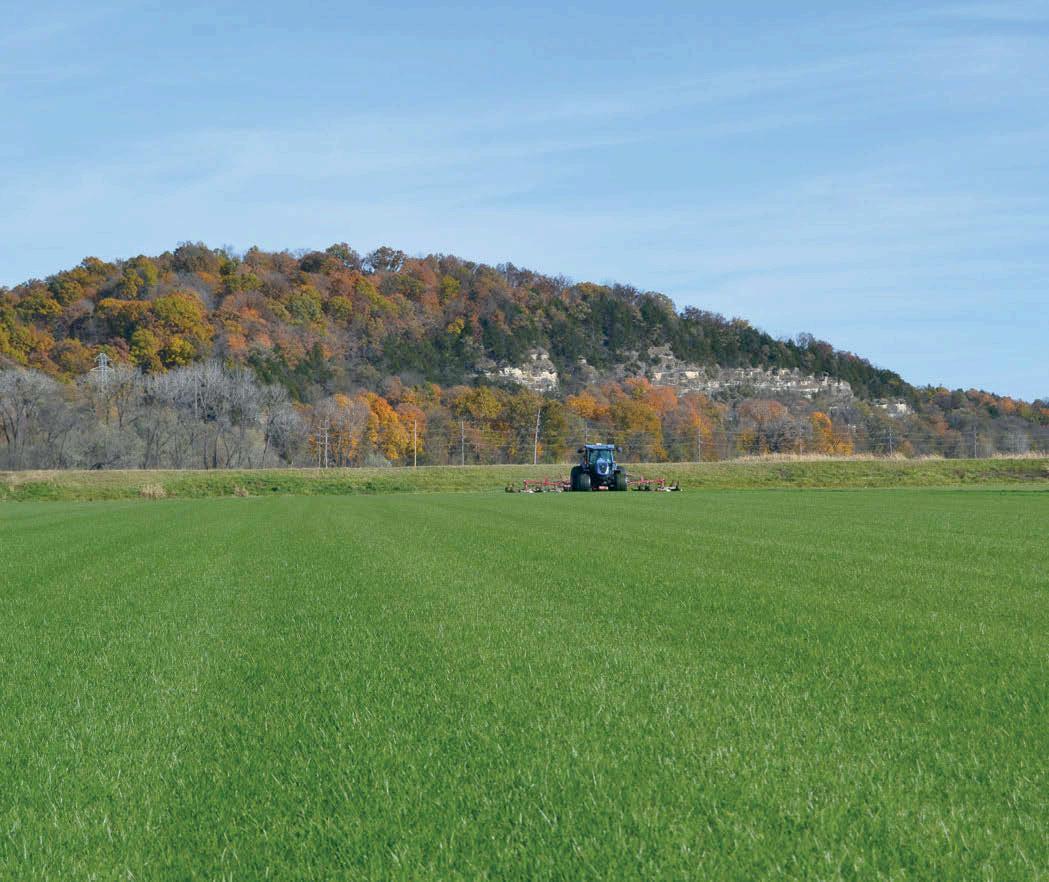
The farm just outside Jefferson City, Missouri, is in a beautiful setting, on great river bottom land, but is sometimes too close to the water.
and Kathy and I were just beyond the newlywed stage, we were the logical choice to pioneer a second location for the company. So, in 1986, we moved to Jefferson City.” They started with 100 acres. “It was just the two of us and one other employee,” says Jim. “We were blessed in what we were about to do. Starting from scratch, we were working on a shoestring, with used equipment from the other farm, working as hard and smart as possible, and making do. We got a mobile home, living in the front and setting up the office in the back. Kathy ran the office and occasionally worked in the field when needed.”
On the River Bottom
Highway 63 runs through the flood plain. The farm was on the river bottom—a blessing and a curse. It had great soil, flat topography, and was close to water. “But sometimes we’re too close to water,” says Jim. “We’ve survived five major floods since we’ve been here and four of those flood events are among the top ten highest river levels in Jeff City.” The first flood hit in 1987. Jim had been told by the gentleman they bought the farm from that if the river rose over the levy, they’d have about two days before the water reached them. “I told our employees to go home that night and come back first thing in the morning,” he says. “Eddie and Tommy were coming to help then, too. Kathy and I woke up in the morning, after only six hours of sleep, with water in the driveway and about a foot of water under the trailer. We pulled the trailer off its pad in knee deep water, moved it to higher ground closer to the river, and put it on blocks about six feet up to keep it dry. Dad came up to help us, too. Working together, we were able to save all the equipment, but we lost all the grass.” That first flood taught them a lot, reports Jim. “Now if the river threatens, we get the equipment out right away. A neighbor just down the road lets us park it there as long as we need to.” With subsequent flooding, they’ve learned the water will be slow to recede, typically covering the fields for at least three weeks. “The grass can’t come back from that,” says Jim. “Replanting depends on the time of year. If it’s June or July, we can get some warm-season grasses going. We can’t plant the cool-season grasses until September and it’s at least nine to ten months after that before we can harvest. So floods really do set you back.” Working together helped balance the challenges, according to Jim. “Tommy and Eddie and I were operating as one company. So our Jeff City site could stay in business by sourcing the sod I needed from them and not cost us too much.”
By 1989, Emerald View Turf Farms had rebounded well and was ready for more expansion. The brothers found a site near Columbia, Illinois, and Tom and his family moved there to begin their third location. Flooding hit the Jeff City site again in 1989, but again the brothers worked through it. The worst flooding occurred in 1993, when all three of Emerald View’s farm sites were flooded and lost all their grass. Jim says, “That was our hardest hit. To keep operating, we were buying grass wherever we could find it. I was buying from Kansas City; Eddie was buying from Peoria, Illinois; and Tommy was buying from Indiana.” Flooding hit Jeff City again in 1995 and 100 percent of that farm’s grass was lost. Jim says, “At that point, Kathy and I looked at each other and said this is crazy. Why are we doing this thing? And then we jumped right in to start the cleanup. This time, with our two other locations not impacted, we could source the sod needed for Jeff City from both O’Fallon and Columbia to reduce our overall costs and keep operating.”
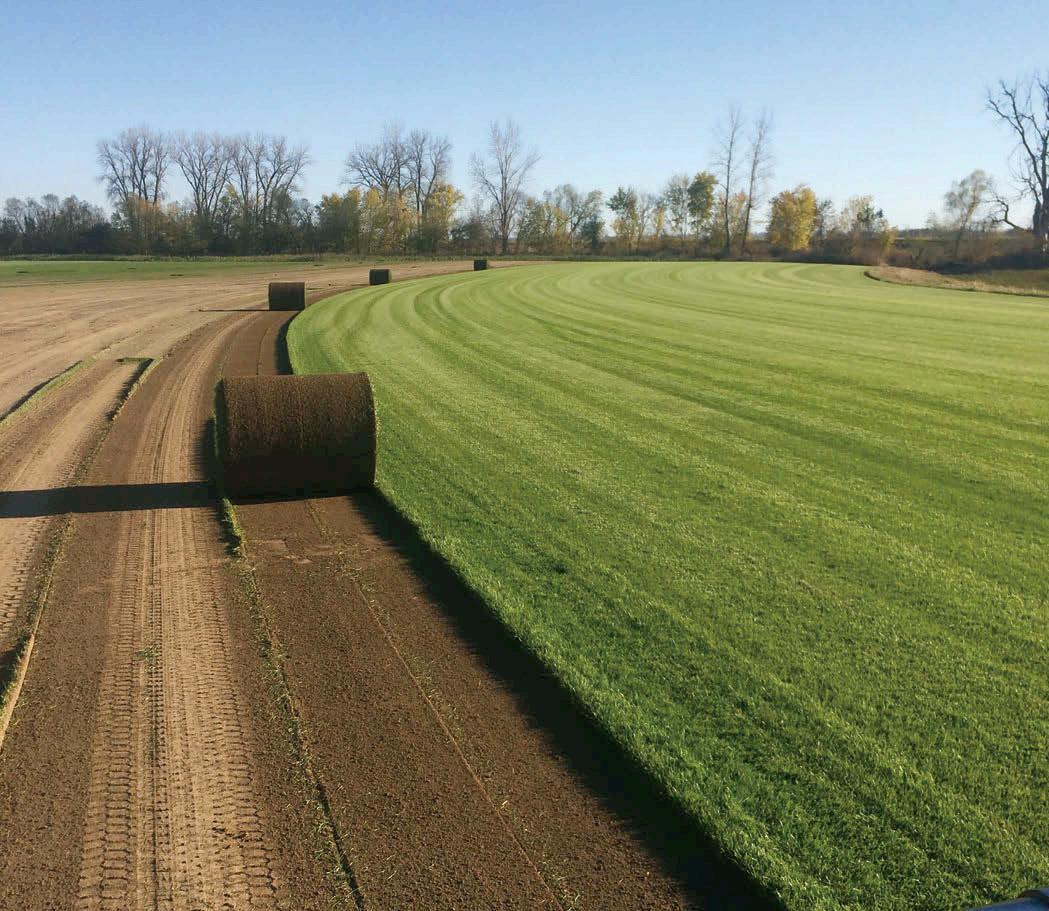
Working together as one company, the three brothers could source the sod they needed from each other, which helped balance the challenges when a single farm was flooded.
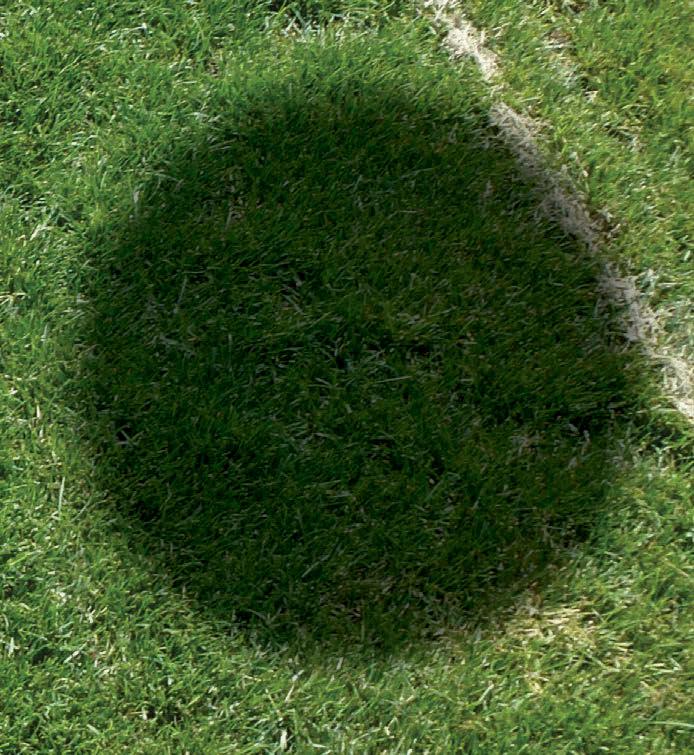
ALLIANCE FORLOW INP U SUSTAINABLE TURF T
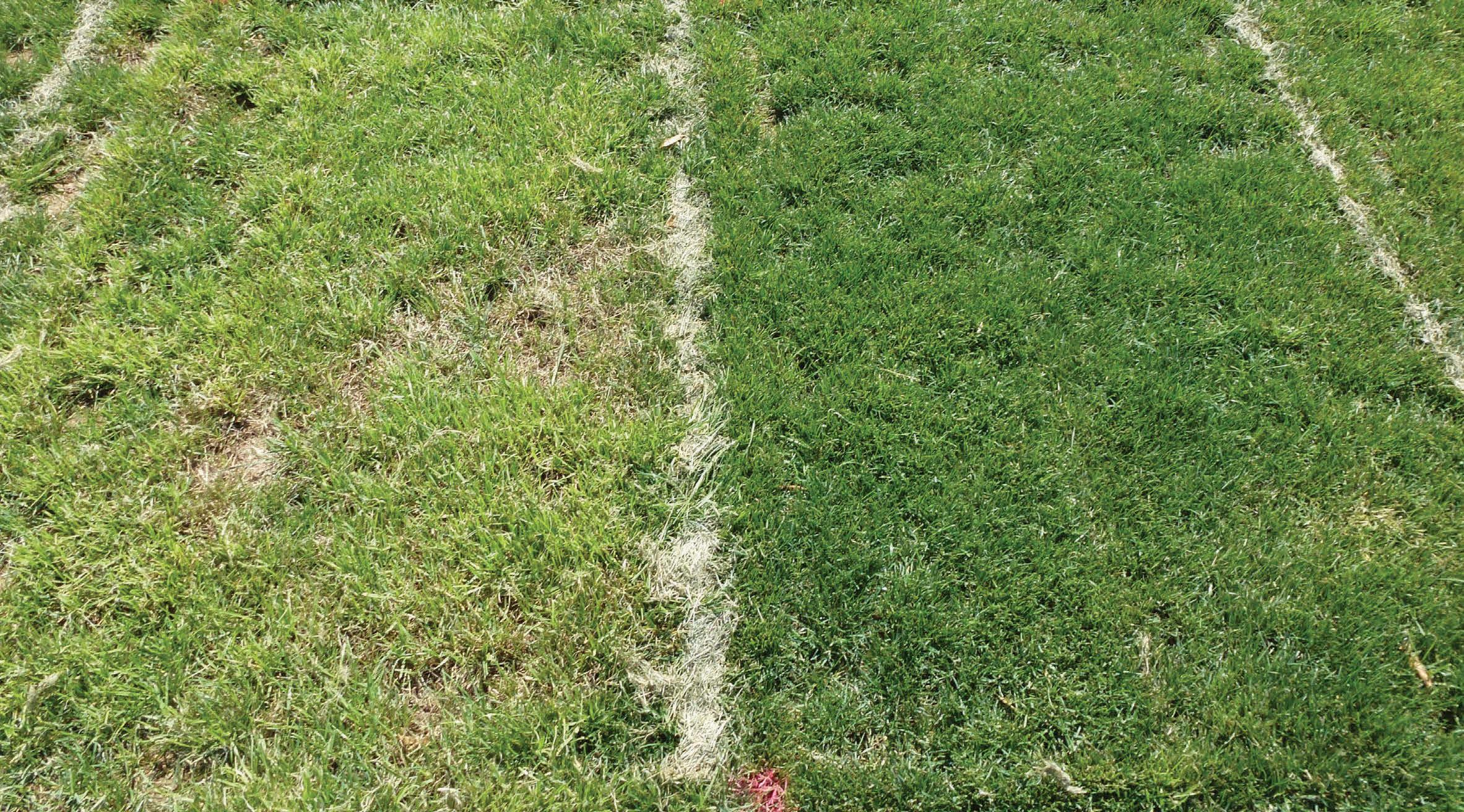

STANDARD VARIETY A-LIST APPROVED VARIETY

Use 40% less water without sacrificing turf quality with A-LIST approved varieties.
The A-LIST is an independent, non-profit, industry initiative, fostering development of sustainable turfgrass varieties and related products that perform their function with less maintenance inputs, thus benefiting the environment. A-LIST monitors a voluntary evaluation program including metrics like water conservation, reduced fertility and traffic, heat, and drought stress tolerances, all with no fungicide or insecticide applications. Products that meet the acceptance criteria can utilize the A-LIST Approved symbol in their marketing and receive the A-LIST Approved tag for use in packaging. To become an A-LIST Approved Variety, a variety must have demonstrated superior performance in A-LIST trials as defined by:
The top LSD group for drought tolerance as measured by percent green cover for each of two years in at least two locations.
Acceptable or better turf quality for each of the two years in at least two locations.
Have been entered into an NTEP trial for the species. For new cultivars that have met the approval standards for performance in
A-LIST trials, final approval will be withheld until the cultivar(s) have been entered into an NTEP trial. FOR APPROVED VARIETIES VISIT WWW.A-LISTTURF.ORG
Members
And though those floods were costly, stressful, and challenging, Jim says, “I hate to dwell on the floods because we’ve been blessed to come through all of them.” For 27 years the three brothers ran together with over 1,500 acres in three locations operating under one company. As the second generation, that was a milestone worthy of pride. Over those years, Emerald View Turf Farms became one of the most successful and well-known sod farms in the Midwest.
Dividing the Company Without Dividing the Family
“With the third generation coming up, we needed to take a look at the future,” Jim reports. “When you’re buying into a company, you’re pretty focused on making payments and don’t look ahead much at things like the succession planning. We didn’t have things structured as well for that as they should had been.” Still, each of the brothers had their own locations and were running their farms pretty much by themselves. “So, when we did the division in 2011 to make way for the third generation, the move to three different companies was relatively easy,” says Jim. “We worked very hard to divide the company and not divide the family. Did everyone get what they wanted? No. But we worked through it because remaining a strong family was so important for all of us. I still talk to Eddie almost every day and would be doing the same with Tommy if we had not lost him to cancer in September of 2020.”
Growing SelecTurf, Inc.
2011 marked a new chapter for Jim, Kathy, and family. The history of the Keeven family is the heart and soul of SelecTurf, Inc. and the entire family is committed to continue serving Mid-Missouri with the same dedication, hard work, and love taught by Ed and Viv.
Jim says, “Our land is on both sides of the four-lane highway that runs from Columbia through Jeff City. For years, we were known as ‘The sod farm on Highway 63.’ When we divided the company, we almost named it that instead of SelecTurf. The original farm in O’Fallon is on a major highway, too. Dad always said that visually you’ll sell more sod than you will advertising it. When folks are ready to think about their yard, they’ll think about that great looking grass they’ve been driving past.” SelecTurf serves all market segments—residential lawns, commercial grounds, athletic fields, golf courses, and anything in between. Their customer base has evolved over the years, with landscape contractors now 80 to 85 percent of their business, and they’ve adapted their grass production to accommodate that. They had developed a niche in sports fields and grew Bermudagrass specifically for it. Jim says, “That market has dwindled for us due to artificial turf. Tom, Jr. grows bermuda in Columbia, so if we do need it for a project, we can get it from him. That’s the beauty of dividing the farm but not family. We can help each other as needed and that benefits all of us.”
Sod producers know the transition zone is tough. As Jim says, “I can grow anything. I just can’t grow it very well throughout the entire season.” SelecTurf now has a little over 550 acres in turfgrasses. That breaks down to approximately 20 percent Zoysia, 10 percent bluegrass, and 70 percent turf-type tall fescue. Nearly all the grass fields are irrigated using Valley pivots. They also “dabble a bit” with soybeans and wheat, generally planting 50 to 60 acres primarily for rotational purposes. SelecTurf went from 1995 to 2019 without flooding. When the 2019 flood hit, it was less severe; leaving about 100 acres of dead grass. For the sections that were not netted, they followed their standard procedure, tilling the dead grass, sand, and silt back into the soil, and replanting at the appropriate time. Jim says, “For the sections that were netted and had no buildup of sand or silt, we bought an AGRI-Vator with seed box from First Products and reseeded into the netting. That allowed us to recapture the netting and gave us sod ready for harvest in nine months.”
This aerial photo of SelecTurf shows the farm’s location on both side of Highway 63. SelecTurf has a little over 550 acres in turfgrass production. Jim Keeven is shown here by a pallet of sod harvested as standard rolls.
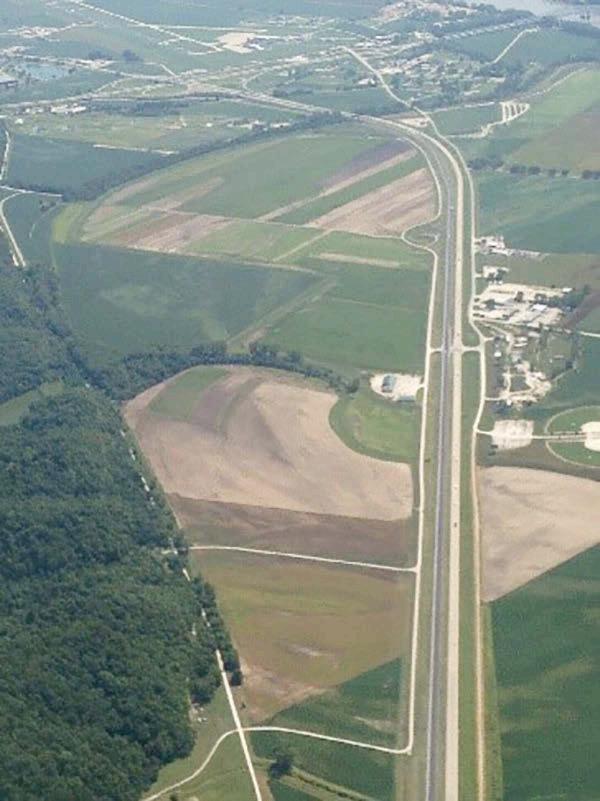
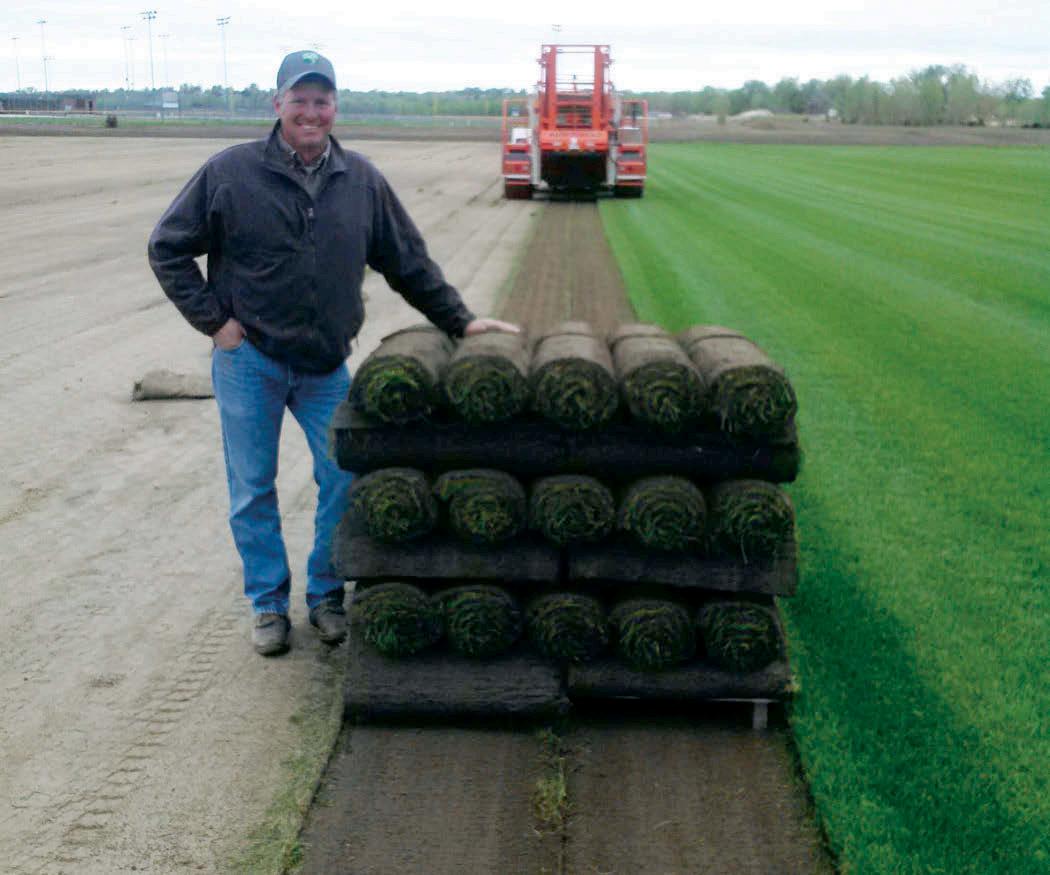
Though Jim says nothing in their operation is “real cutting edge,” SelecTurf is quick to adopt new technology. They purchased one of the first Trebro Autostack harvesters and now have an Autostack II. “It’s just one machine, but it’s cutting all day long,” says Jim. They also have a Bucyrus AR big roll harvester. Their tractors have GPS guidance. Jim also has devised an innovative renovation method for golf course fairways. They harvest out a 7.5-inch strip of the cool-season fairway grass, skip 18 inches, and repeat the process across the area to be renovated. They install a 7-inch strip of zoysiagrass sod, centered in the bare 7.5inch space, leaving a .25-inch space of bare ground on each side of the zoysia strip. Jim says, “The zoysia will grow together into the cool-season grass and over a period of three years infiltrate the entire fairway at a quarter of the cost of a total resodding.” The zoysia growth comes from the outside edge, so putting more edges out there provides more growth. The golf course superintendent can see the zoysia, which makes it easier to determine what it needs in water, fertilizer, or other inputs. The membership can see what they bought, so they’re happy, and even happier in three years when they have a solid zoysia fairway. Jim says, “We modified a big roll harvester to divide a 21inch strip into three 7-inch strips during the harvesting process. Then we just line up the harvested 7-inch strips on a big roll, six strips on the roll. We unroll the strips on the fairway and physically place them by hand where we’ve cut out the existing grass. It’s a lot of hand labor, but even adding in the increased labor costs, it’s less expensive than a total resodding.” SelecTurf owns three semis and one straight truck. Jim says, “We’re pretty fortunate. Our location is close enough to our market that our trucks can make multiple trips per day. If those are one stop drops, we sometimes can get in four or five trips.” They do sometimes hire a truck for deliveries to the Kansas City area. It’s approximately 160 miles away. “The people we’re working with can, and will, unload and place pallets for the customer just like our staff does.”
The Third Generation
Family—past, present, and future—is the core of the company and that legacy continues with the third generation. Jim says, “We are so blessed. Clinton and Kelsey, our two oldest, joined the business and are buying stock in it. Kathy and I believe they deserve the opportunity to be successful with something they have built. But we know they do need to earn it, so they appreciate its value, and that is happening now. It will be fun to watch them experience owning and running a business and to see all they will achieve.” Clinton’s focus on the sod farm started in grade school. He always knew he wanted to work in the business. Instead of a four-year college, he chose the highly ranked Commercial Turf and Grounds program at Linn State Technical College in Linn, MO. He then interned for eight months with Warren Bell’s turf team at BioGrass Sod Farm in Sandy, Utah, just outside Salt Lake City. Jim says, “Clint is skilled in all aspects of the production, harvest, and delivery side of the company. He leads the team to provide the best service and highest quality for our customers. Clint is married to Jill, and they have three children, James who is four, Tristan who is two, and Susannah who is one. And they recently reported they are expecting, with their fourth child due in June.”
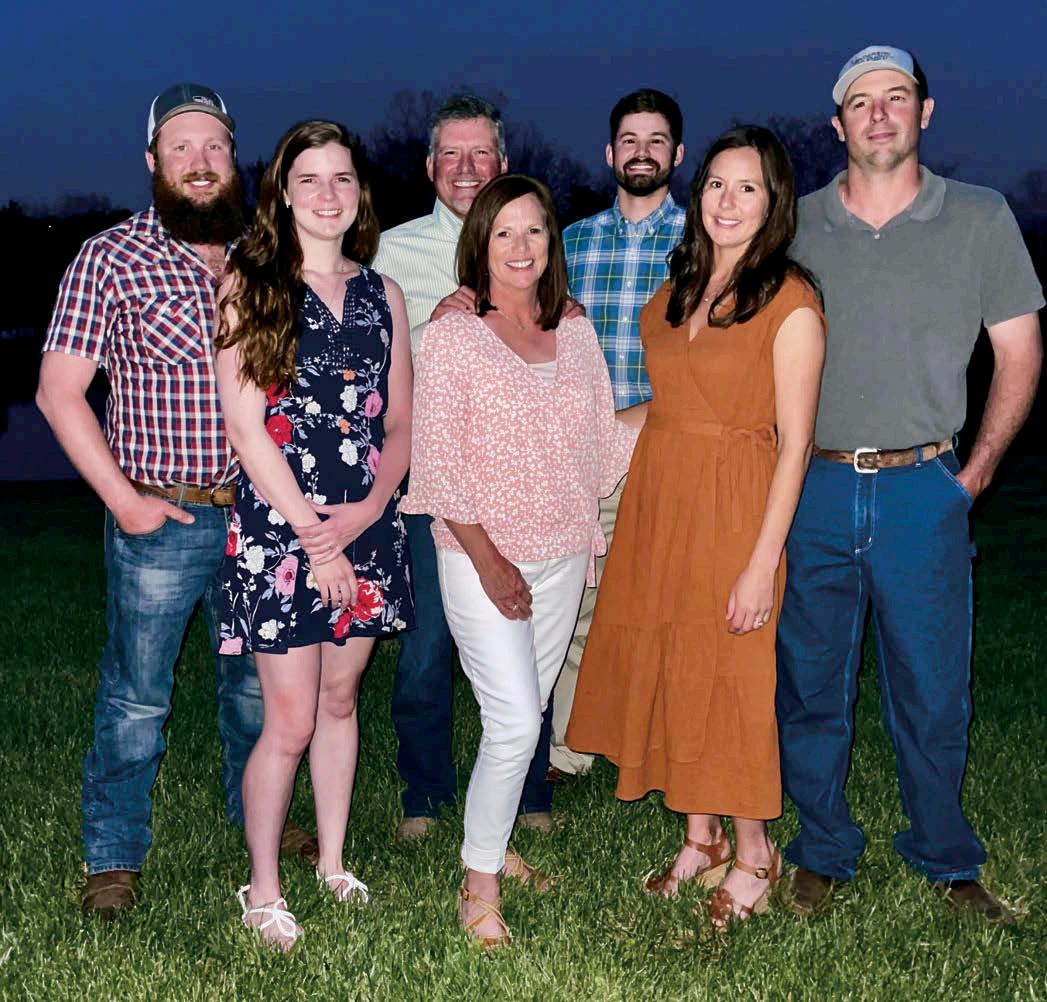
Pictured here are the second and third generations of the Keeven family. From left to right, are Clinton and Jill Keeven, Jim and Kathy Keeven, Joe Keeven, and Kelsey and Sean Sandbothe.
Jim and Kathy are thriving in the grandparent role, and their smiles show it! Pictured here, with Kathy and Jim, are the grandkids, from left to right Charlie (3), James (4), Tristan (2 - standing), Allison (5), and Susannah (1).
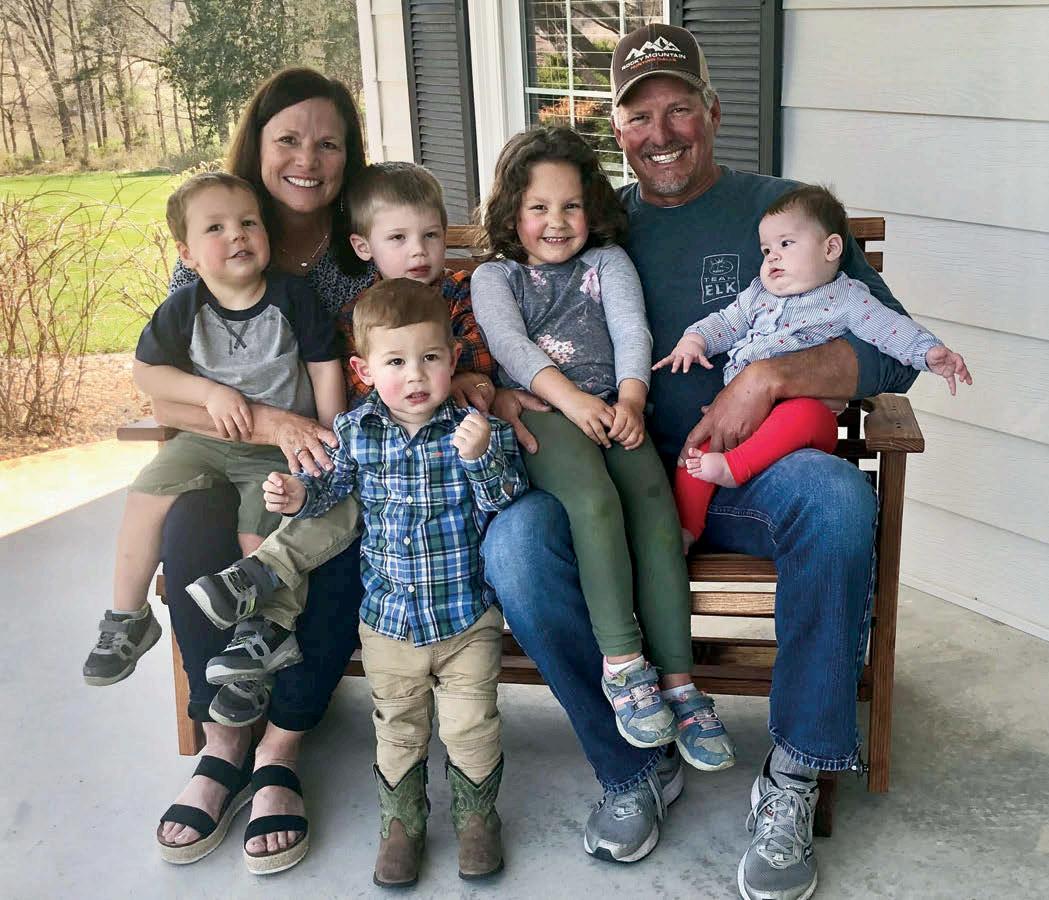
Kelsey earned a business degree at the University of Missouri in Columbia, MO. After graduation, she worked for an IT company, and then took a position with another company. Jim says, “Though we’d been teasing her that we needed an accountant when she was attending college, it was an indepth discussion pointing out how her skills matched the needs we had in the office and the opportunities for her here, that led to her joining the turf team full time in the spring of 2013. Her responsibilities range from managing the office, sales, marketing, business development, the website, social media, and other jobs that keep our workflow running smoothly. Kelsey is married to Sean Sandbothe. They have two children, Allison who just turned five, and Charlie who turned three on November 16, 2021.” Jim and Kathy’s youngest son, Joe, has pursued other interests. He excelled at soccer throughout high school and picked up a scholarship to play soccer at William Jewell College in Liberty, MO. He redshirted a year there and played goalkeeper for five years, while earning his business degree. Jim says, “Right after graduation he moved to Colorado to be a trout fishing guide. I admit I was a bit jealous because he did what I wanted to do when I was a kid. After a year, he determined that would be a hard way to make a living. He now lives in Kansas City and works as an account manager for Ryan Transportation.”
The SelecTurf Team
With the day-to-day office operations now Kelsey’s realm, Kathy usually only needs to come in once or twice a week to pay bills and keep track of the books. “Before Covid, most people called in their orders and we went through all the questions with them, step by step,” Jim reports. “When the shutdowns started and we went paperless, more orders came in electronically. Kelsey has convinced most of our repeat customers, especially the Besides the four family members, SelecTurf employs seven full-time staff members. Jim and Kathy are quick to acknowledge their contributions to the business and express their appreciation of them. The SelecTurf website’s “Meet Our Turf Team” section kicks off with this, “Every member of our team is a thought leader who has made significant contributions to our farm. Each one brings a unique set of skills and expertise to our organization.” And that section includes this statement from Kathy, “We feel so blessed to have each one of our employees. They are all hard-working, dedicated people that feel more like family than anything else. Each one of these people is an integral part of SelecTurf, Inc. and we couldn’t run the farm without them.”
In the transition zone, there are two to three months during the year when nothing is happening with the sod. Jim says, “From the beginning, Kathy and I have believed in taking care of our people. We think it’s better for them and for us to keep them on during that downtime, so our key people work a full week year-round. We have great people, and we want to keep them, so we just do it.” Most of that downtime has been spent working on general upkeep around the farm, and in the shop, primarily on equipment maintenance and repair. Jim reports that, this year, they’ll be trying out some options to keep the trucks running and generating income. Finding additional personnel has been difficult in the tight labor market, with truck drivers the hardest to find. For seasonal part-time workers, they have occasionally employed high school students, but most have so many activities like summer sports, sports camps, and band camps, they have few hours available. They’ve also tried
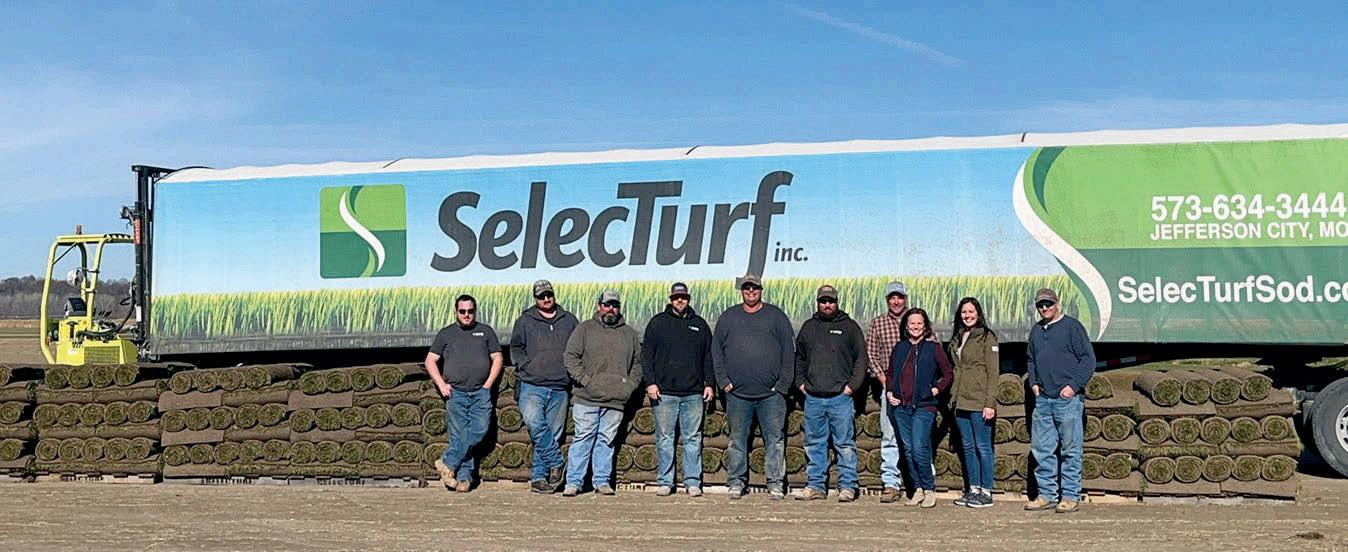
bringing in college students from the Linn State Technical College agriculture department, for either internships or jobs, but most take golf course or sports field options. Jim says, “We’re exploring bringing in some H2A workers, but we’re not sure about that yet.”
Marketing and Customer Interaction
The company’s website, www.selecturfsod.com, is a key marketing tool. Jim says, “Kelsey has done a world of good with our website. It has a lot of history in it; that was really important to Kathy and me.” It’s customer friendly, providing need-to-know information in a quick-read format. It offers multiple options to get a quote or place an order online, via email, texting, or by a phone call. The company’s mission statement is posted on the website under this heading, “Our LifeLawn Commitment to You.” It states, “We strive to exceed our customers’ expectations with top quality turfgrass and unprecedented service; to be good stewards of our land and water so that we protect them for the future; to be courteous and professional with everyone we come into contact with, so that your experience with us is memorable.” Catchy statements pop up in multiple places. “We’ll Make Your World Green and Gorgeous.” “We are a family-run business, and we care deeply about what we do.” “Founded in 1951, we are dedicated to providing the highest level of service and quality turfgrass. Your pride is our greatest satisfaction!” “From our fields to your lawn, we have you covered!” Just one example of the website’s timesaving features for both the customer and staff is the pre-contact preparation prompter. “We will ask these questions when you order sod: What type of turfgrass do you want? How many square feet do you need? Pick-up or delivery? Date and time? Are you needing any other items: Seed, Fertilizer, Sod Pins, etc.?”
Balancing Work and Family
“In a family business, you learn to care for your business not just your job,” says Jim. “As an owner, you’re involved all the time, 24/7, but you have to be careful not to let it consume you. Kathy has made sure that doesn’t happen, at times telling me, ‘Jim, sometimes you have to back away from it,’ and she’s right. So, while I’ve worked hard on our sod farm, it’s not my identity. I don’t want it to dictate who I am, but it is deeply ingrained in my life.” He adds, “Starting a business, you’re working as many hours as you can, just to make ends meet. As you become better at what you do and more successful, you get a little more time away from work. Something I learned from Mom and Dad, and that we’ve made a point of here at the farm, is that we don’t work on Sundays.” Jim and Kathy are thriving in the grandparent role. Jim says, “Grandkids are so much fun! We are so thankful that we get to see them a lot. Spending more time with them was the draw that prompted Kathy to cut back her office hours. She has started a special 'cousins’ night,' that we love with all four of the oldest grandkids. It’s an overnight stay with movies, popcorn, and tons of giggles.” Vivienne is doing well, he reports. “She has lived at home by herself since we lost Dad about ten years ago. She is 91 years old and as sharp as ever. Two of my sisters are almost next door to her and make sure she has everything she needs.” Viv is still the head cook and hostess for the family Thanksgiving celebration, always held on the following Saturday. Jim reports they now rent a church hall for it because when all the kids, spouses, grandkids, and great grandkids show up, there are over 100. “Mom cooks a turkey and about 40 ducks. (She uses the Bing Crosby duck recipe she provided for the TPI cookbook years ago.) And she makes her famous potato cakes, which don’t sound good, but are so great we still fight over who gets the biggest piece. Everyone else brings a dish or two, so we end up with four or five tables filled with food. Christmas is a more casual ‘open house’ at Mom’s with family invited to come and go as it fits their plans.”
A Passion for Hunting and Fishing
Jim says, “We grew up with hunting and fishing. Dad enjoyed hunting, especially for quail. When Missouri’s quail population dropped, we moved on to ducks and deer. Mom is the family’s best at fishing, especially for bass.”
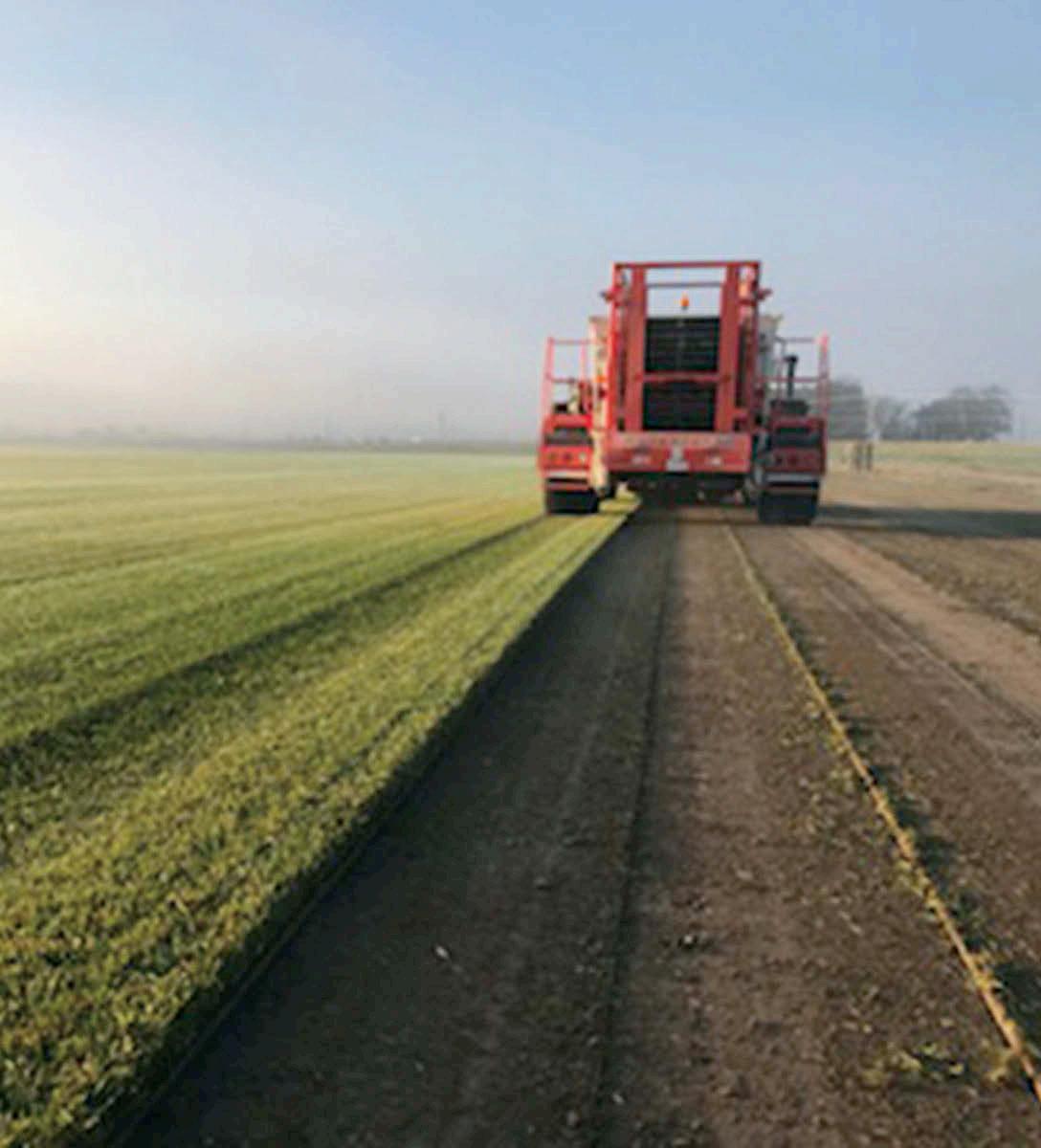
“We’ll Make Your World Green and Gorgeous,” is one of the catchy phrases posted on SelecTurf’s website.
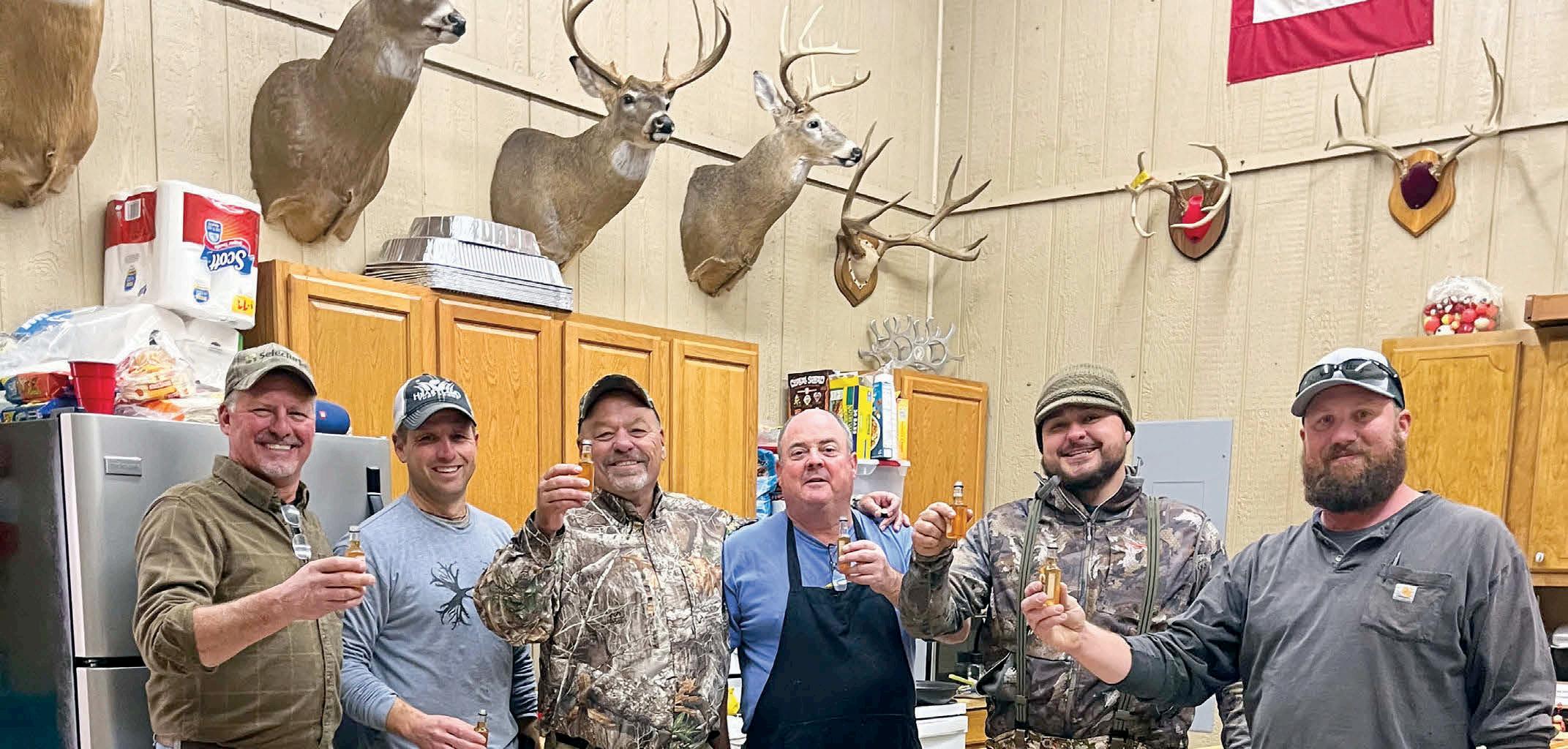
The three brothers teamed up again to buy land near the Mississippi River, so they’d always have a place to hunt. Gathered at that facility for the TLI Auction Deer Hunt, postponed from 2020, are from left to right, Jim Keeven, Tom Keeven, Jr., Tim Wollesen, Hank Kerfoot, Colton Wollesen, and Clinton Keeven.
The TLI Auction Deer Hunt of 2020 was combined with an onsite dinner prepared by Hank and Mary Kerfoot. The crew gathered to take part in that event, pictured here from left to right, are Tim Wollesen, Lucy Keeven (Tom, Jr.’s daughter) Colton Wollesen, Jim Keeven, Mary Kerfoot, Eddie Keeven, Hank Kerfoot, Kathy Keeven, Tom Keeven, Jr., and Clinton Keeven.
Jim’s sons are hunters, too. He says, “This year, Clint, Joe, and I went elk hunting in Colorado for a week. I had done it separately with each of them, but this was the first time all together. That was special. Fishing on the Missouri River that borders our farm is great fun, too. From about 16 to 18, Clint and his buddies practically lived on that river and became so skilled at catfishing that Clint taught me how to catfish.” Tommy, Eddie, and Jim decided years ago that they needed to buy some land to make sure they’d have a place to hunt. They bought a place near their parent’s duck club on the east side of the state which is bordered by the Mississippi River. Jim says, “We did put a lot into it, in planting and maintenance, but it has been worth it. It’s so special to share it with friends. In early November, I spent five days there with Randy Graff and Marty Thiel of Graff’s Turf in Fort Morgan, Colorado.” Some of the most popular The Lawn Institute (TLI) fundraiser auction items have been the duck hunts and deer hunts contributed by the Keeven brothers. Those events are frequently combined with a dinner contributed by and prepared onsite by Hank and Mary Kerfoot of Modern Turf, Rembert, SC. The combination deer hunt and dinner auctioned off during TPI’s 2020 International Education Conference & Field Day was delayed due to Covid-19. In late November of 2021, Tim and Colton Wollesen of Sales Midwest in Olathe, Kansas, joined the Keevens and Kerfoots for that event. Jim says, “Tim and I became good friends when we both served on the TPI Board. It’s great to have that level of friendship with someone you do business with; that’s another benefit of TPI.” As 2022 rolls in, Jim Keeven is focused on the goal of growing the legacy—for his faith, family, business, association, and industry—building on the strong roots of the past, meeting the challenges of the present, and welcoming the opportunities of the future.
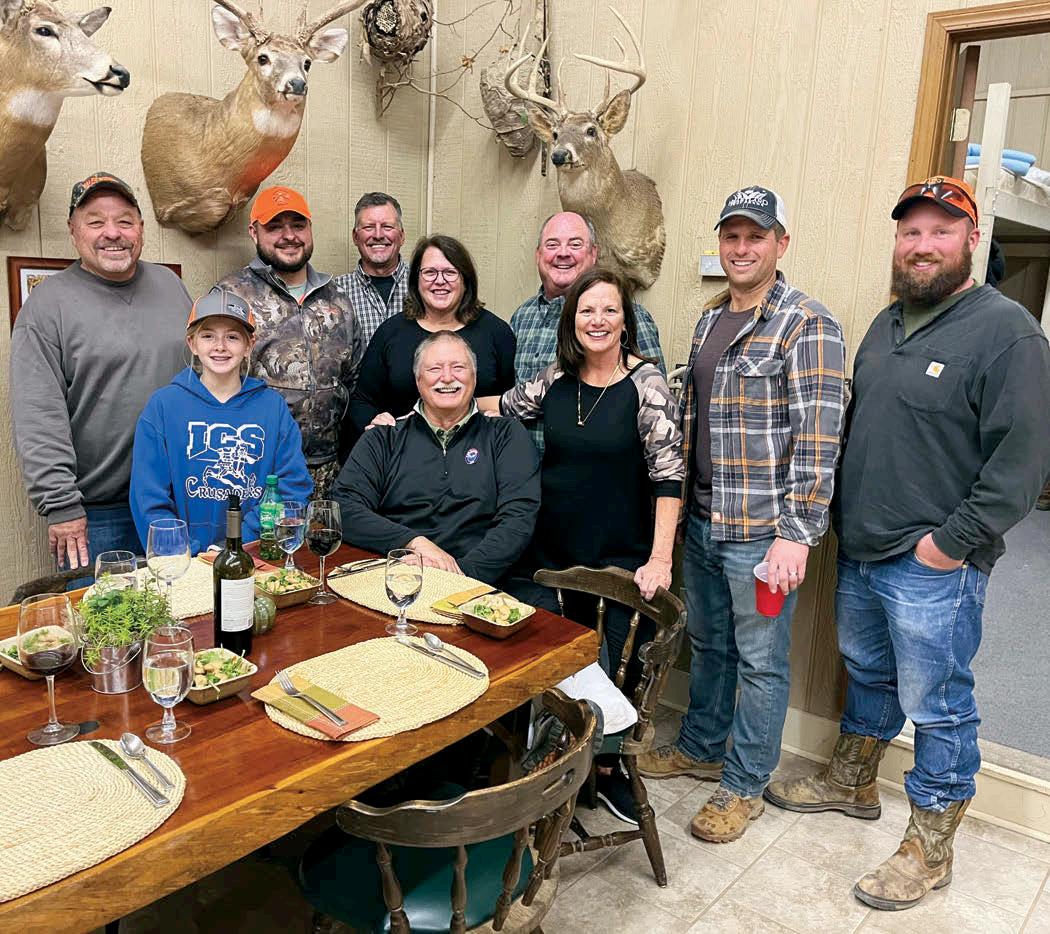
Suz Trusty is co-editor of Turf News. All photos courtesy of SelecTurf, Inc. and the Keeven family.
